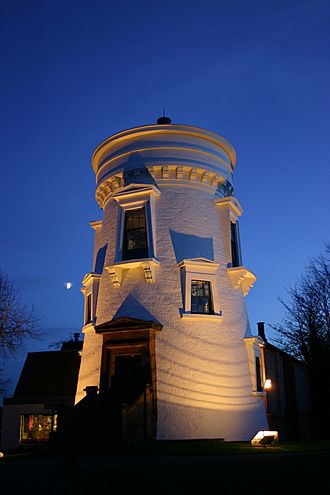Dumfries Museum facts for kids
Quick facts for kids Dumfries Museum and Camera Obscura |
|
|---|---|

Exterior view of the Camera Obscura
|
|
| General information | |
| Architectural style | Victorian and modern |
| Town or city | Dumfries |
| Country | Scotland |
| Coordinates | 55°03′55″N 3°36′53″W / 55.0652°N 3.6146°W |
| Renovated | 2011 |
The Dumfries Museum and Camera Obscura is the biggest museum in the Dumfries and Dumfries & Galloway area of Scotland. It holds many collections that tell the story of local history, going back to prehistoric times. The museum is also home to the world's oldest working camera obscura. You can visit the museum for free, but there is a small charge to experience the camera obscura.
Contents
Museum Collections
The museum has many interesting items. These collections cover the natural history and human past of the region. You can see everything from rocks and fossils to old clothes and early photographs.
Cool Things to See
Some of the special items you can find here include:
- A copy of the skull of Robert the Bruce, a famous Scottish king. You can also see some of his leg and foot bones.
- A Bronze Age burial site. This includes the remains of a 35-year-old man from the beaker people.
- A large group of Roman and Celtic stone crosses. These were used as monuments or grave markers.
- A copy of the very first bicycle. It was designed by Kirkpatrick Macmillan.
- Old photos from the collection of Dr Werner Kissling.
- Personal items that belonged to Thomas Carlyle, a famous writer.
- Fossil tracks from ancient reptiles. These were found in local Permian sandstone, including from Corncockle Quarry.
Museum History
The building where the museum is now started as a four-story windmill. It was built in 1798 on Corbelly Hill, which is the highest point in Maxwelltown.
From Windmill to Observatory
In 1834, the Dumfries and Maxwellton Astronomical Society bought the windmill. Over the next two years, they turned the tower into an Observatory. With advice from the polar explorer Sir John Ross, they bought a telescope. The observatory was finished in 1836. Sadly, it was too late to see Halley's Comet that year. However, it was used as an observatory until 1872.
Becoming a Museum
The main hall of the museum was built in 1862. This new space held the collections of the Dumfries and Galloway Natural History & Antiquarian Society. In 1981, the museum got a big new addition. This included a new gallery, a shop, a research room, and offices for the museum staff. The outside of the windmill tower was also updated in 2011.
The Camera Obscura
The camera obscura at Dumfries Museum is the oldest one in the world that still works. It has been used continuously since 1836.
How it Works
This special instrument is located at the very top of the windmill tower. It gives you a full 360-degree view of the area around the museum. The image is projected onto a special table below. You can operate it using a simple rope. To keep the camera safe, it only works during the summer months. It also needs clear weather conditions to show a good image.

